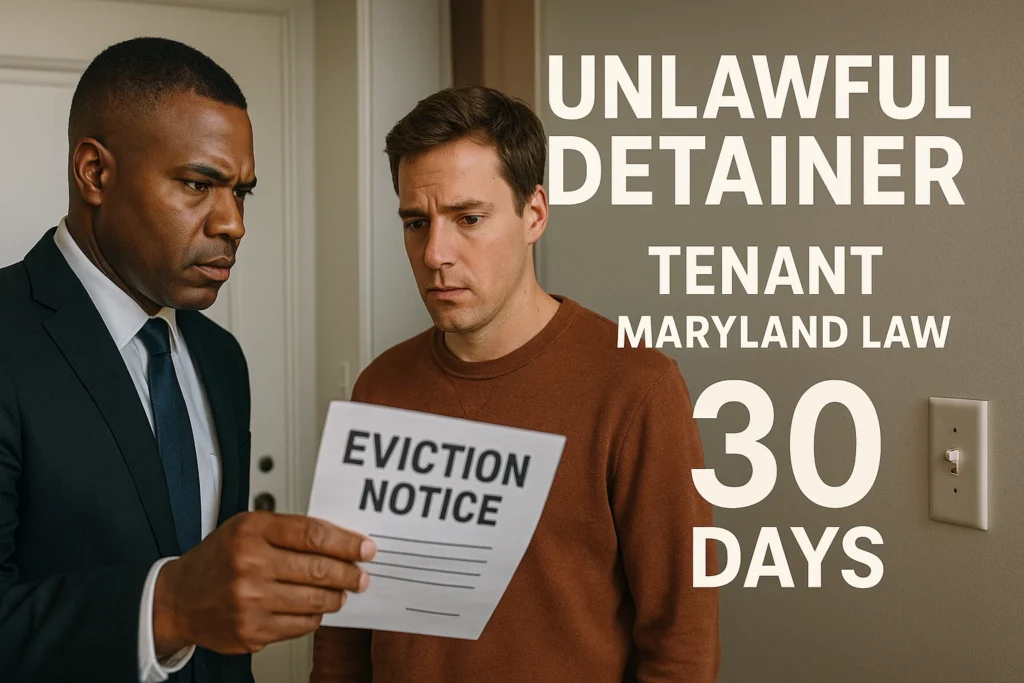Unlawful detainer is a legal process. It starts when a tenant stays in a home after the legal right to remain ends. That issue often appears once a lease ends or a landlord ends a month‑to‑month rental. Maryland landlords must follow each legal step before any tenant removal.
Any tenant who receives a 30‑day notice must act. Failure to leave lets the landlord ask the court to step in. The landlord files an unlawful detainer suit. The suit seeks possession, not rent. Courts treat each case with care.
Both landlords and tenants must know the law. Maryland statutes protect both sides. Each party must follow a clear legal path. A missed step can cause delay, court loss, or extra cost. Good knowledge offers the best shield.
Unlawful detainer law centers on fairness. Judges need proof that each step meets the rules. If the landlord meets every rule, the court can order the tenant to leave. If not, the judge may dismiss the suit. Each detail has weight.
What Is an Unlawful Detainer in Maryland?
Unlawful detainer is a lawsuit a landlord uses when a tenant stays in a home after the legal right ends. The issue often arises once a lease ends or a landlord ends a month‑to‑month tenancy. A clear notice reaches the tenant, the deadline passes, yet the tenant still occupies the property.
The action concerns possession alone. The tenant may owe no rent. The court asks one question: Does the tenant hold any right to stay? A “no” answer lets the judge return control to the landlord.
Maryland law sets a strict path. The landlord serves a written notice, then waits the full notice period. After that, the landlord files the case in District Court. Judges review the notice, the lease status, and any defense the tenant presents. Solid proof wins.
The suit protects both sides. It blocks illegal lockouts and gives landlords a lawful route to regain property. The final court order carries full force and closes the dispute.
Maryland 30‑Day Notice Rule: Unlawful Detainer Case
Maryland landlords must send a written 30‑day notice before any court step. The rule covers month‑to‑month renters and tenants without a lease. The notice states the landlord’s intent to end the tenancy. It also lists the exact move‑out date.
The 30‑day clock starts on the day of delivery. Tenants then have the full period to leave. A tenant who stays past the deadline risks a lawsuit. The landlord can file an unlawful detainer complaint in District Court. That action seeks to regain possession, not rent.
Maryland judges demand solid proof of the notice. Landlords must show the service date and the delivery method. Courts also need evidence that the tenant got the papers. Any error or absent detail can sink the case.
Local rules may give tenants more time. Some counties extend the notice period. A city code review protects both sides. Legal aid offices explain these rules to tenants. Landlords also must verify each local requirement before the court.
The Legal Steps in an Unlawful Detainer Case
Once the 30 days end, the landlord can file in District Court. The complaint must include the notice, delivery proof, and a request to regain possession. The court then schedules a hearing. Both sides must appear. The judge listens and makes a decision.
At the hearing, the landlord explains what happened. They must prove the notice was legal and the tenant stayed past the deadline. The tenant can defend the case. They can bring records, speak to the judge, or explain why they stayed. The court looks at both sides before ruling.
If the judge agrees with the landlord, the court issues a writ of possession. This allows the sheriff to schedule an eviction. Only the sheriff can carry out the removal. Landlords cannot lock out tenants without a court order. That is illegal under Maryland law.
If the tenant wins, they may stay. The judge may also give more time to move. Each case is different. The outcome depends on facts, notice, and legal steps. Courts expect both sides to act in good faith and follow the law.
Tenant Rights in Maryland Unlawful Detainer Cases
Maryland tenants have strong legal rights. They must receive proper notice before any court case begins. Tenants have the right to respond, speak in court, and show evidence. They also have the right to request more time to leave if needed.
Tenants should never ignore a 30-day notice. Courts do not delay because someone missed a deadline. Tenants who attend the hearing can explain their side. Judges want both parties to speak. Missing the hearing gives the landlord the upper hand.
Some tenants believe landlords cannot remove them without a lease. That is false. A landlord can end a month-to-month rental with a valid 30-day notice. If that notice was given, and the tenant stayed, the court may order removal.
Landlords also cannot retaliate. If the tenant made a complaint or requested repairs, the court may protect the tenant. Maryland law stops landlords from using unlawful detainer to punish tenants for legal actions. Tenants should tell the judge if that happened.
What Landlords Must Know Before Filing
Landlords must follow the rules. Giving proper notice is not optional. Maryland courts require clear, dated, and written 30-day notices. If the notice is wrong, the court can throw out the case.
A landlord must never change lock, turn off utility, or move a tenant’s belonging. That is against the law. Only a court order and a sheriff can remove a tenant legally. Breaking these rules bring serious fine and court problems.
All documents should be kept safe. Proof of notice, dates, rent payments, and communication help in court. Judges look for facts. A landlord who shows full records has a stronger case. Guesswork and missing paperwork often lead to delays.
Unlawful detainer is not the same as nonpayment of rent. Each has its own process. Filing the wrong type of case can waste time and money. Always know the difference before filing in court. Legal advice helps prevent mistakes.
Common Mistakes to Avoid
Tenants often make the mistake of ignoring the notice. That leads to surprise court dates and evictions. Reading and responding to notice is the best way to protect your rights. Tenants should prepare before the court and never skip the hearing.
Landlords also make key errors. Some file cases too early or forget to count the full 30 days. Others use unclear or verbal notices. Those mistakes can ruin a strong case. Maryland courts expect full legal steps, not shortcuts.
Some landlords try to remove tenants without court approval. That causes more harm than good. It can lead to lawsuits, court penalties, and even police action. No landlord should risk their case by skipping a legal step.
Both sides must act calmly and follow the law. The court system exists to handle these matters fairly. Mistakes delay justice and cost money. Knowing the law makes the process smoother and avoids conflict.
Final Words
Unlawful detainer cases must follow a clear process. The 30-day notice is not just a form. It is a legal step that begins everything. Landlords must respect it. Tenants must respond to it. No one can skip the process.
Maryland courts aim for fairness. They do not favor landlords or tenants. They follow facts, deadlines, and laws. The side that prepares well often wins. Courts reward those who follow each step.
Tenants should learn their rights. Landlords should document every action. Each has a role. Each has a duty to follow the law. Trust in the legal system helps resolve disputes.
Everyone benefits from a fair, lawful process. Maryland law gives both parties a voice. Use it wisely, prepare fully, and stay informed. Knowledge and action are your best legal tools.
Disclaimer: This article is for general information only. It does not offer legal advice. Please contact a Maryland attorney for legal help with your situation.



